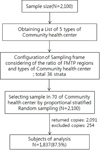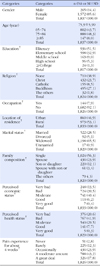Abstract
Purpose
The purpose of this study is to obtain information of use of complementary and alternative medicines (CAMs) and any reported adverse effects of them on vulnerable elders in a community.
Methods
1,837 elderly subjects aged 65 or higher with health problems were selected from those who were enrolled in a public health care center and received visiting health management services. A proportional stratified sampling method was used. Data collection was completed by face to face interviews using a structured questionnaire. The descriptive statistics and χ2-test were used to analyze the data.
Results
The prevalence of CAM use last year was 57.5%, and 10.4% of the subjects reported adverse effects of the therapies. The mean score of the subjects' attitudes towards CAM was 4.1±3.44 (range 1~10). The major sources of advice and exposure to CAM therapies were most likely to be from family and friends (72.5%). The primary reason for choosing CAM was to manage symptoms and relieve pain (86.6%).
Figures and Tables
References
1. Lee SJ. The roll of complementary and alternative medicine in integrative medicine. Hanyang Med Rev. 2010; 30(2):75–83.

2. Korean Academy of Medical Sciences · Korean Medical Association. Development and application of evidence level for complementary therapy-summary. Seoul: Korean Medical Association;2005. p. 14.
3. National Center for Complementary and Alternative Medicine. Get the facts: What is complementary and alternative medicine [Internet]. Maryland: National Center for Complementary and Alternative Medicine (NCCAM);2005. cited 2012 July 15. Available from: http://nccam.nih.gov/health/whatiscam/.
4. Cho NH, Kim SH, Woo EK, Lee J, Lee S, Cho HS. Utilization level and associated factors of complementary and alternative medicine in the older population before death. Korean J Hosp Palliat Care. 2004; 7(1):37–48.
5. Park HM, Jang IS, Lee SD. Hepatotoxic events associated with herbal medicinal products, folk remedies and food supplements in Korea. J Korean Orient Med. 2005; 26(2):152–165.
6. Yamashita H, Tsukayama H, Sugishita C. Popularity of complementary and alternative medicine in Japan: A telephone survey. Complement Ther Med. 2002; 10(2):84–93.

7. Horrigan BJ. New NHIS survey reveals that 38% of American adults use CAM. Explore (NY). 2009; 5(2):71–73. http://dx.doi.org/10.1016/j.explore.2008.12.006.

8. Tindle HA, Davis RB, Phillips RS, Eisenberg DM. Trends in use of complementary and alternative medicine by US adults: 1997-2002. Altern Ther Health Med. 2005; 11(1):42–49.
9. Xue CC, Zhang AL, Lin V, Da Costa C, Story DF. Complementary and alternative medicine use in Australia: A national population-based survey. J Altern Complement Med. 2007; 13(6):643–650.

10. Ock SM, Choi JY, Cha YS, Lee J, Chun MS, Huh CH, et al. The use of complementary and alternative medicine in a general population in South Korea: results from a national survey in 2006. J Korean Med Sci. 2009; 24(1):1–6. http://dx.doi.org/10.3346/jkms.2009.24.1.1.

11. Shin KR, Park SY, Shin SJ. A study on the use patterns of alternative therapy in the elderly. J Korean Acad Adult Nurs. 2004; 16(1):111–122.
12. Oh K, Kim KS, Kwon SH, Park JW. Research trend of complementary and alternative medicine. J Korean Acad Nurs. 2006; 36(5):721–731.

13. Jang EH, Park KS. A comparative study of nurses and physicians' attitudes about complementary and alternative therapy. J Korean Acad Adult Nurs. 2003; 15(3):402–410.
14. Kim BW. A study on the utilization of cancer patients using complementary and alternative medicine [master's thesis]. Seoul: Yonsei University;2005. 63.
15. Han KS, Im NY, Song KA, Hong YH, Kim JI, Kim KH, et al. The analysis of trends in complementary and alternative therapy (CAT) in nursing research in Korea. J Korean Acad Fundam Nurs. 2003; 10(3):392–398.
16. Jun MH, Uhm DC, Jeong S. The analysis of the Korean nursing research trends on complementary and alternative therapies for cancer patients. J Korean Oncol Nurs. 2009; 9(1):67–75.
17. Yang NY, Shin KR. The analysis of research trend about complementary and alternative therapy (CAT) in nursing of Korea. J Korean Acad Adult Nurs. 2003; 15(2):226–235.
18. Ko Y, Lee IS. Factors affecting the self-rated health of vulnerable elderly. J Korean Acad Community Health Nurs. 2009; 20(1):31–40.
19. Ernst E, Cassileth BR. How useful are unconventional cancer treatments? Eur J Cancer. 1999; 35(11):1608–1613.

20. Cho SH, Kim MR, Kim SJ. Cyanide poisoning after consuming a large amount of gingko nuts. J Korean Soc Emerg Med. 2003; 14(4):458–461.
21. Cho SY, Lee SJ, Cho SB. Multiple scarring following removal of pigmented nevi by acupuncture in an oriental clinic. Korean J Dermatol. 2010; 48(6):537–539.
22. Kim SC. Clinical characteristics of poor responders to acupotomy and safety pretreatment management. J Korean Acupunct Moxibustion Soc. 2008; 25(4):117–125.
23. Shin HC. The study on acupuncture treatment of recurrent cystitis and lower urinary tract infection. J East-West Med. 2010; 35(4):49–64.
24. Jang IS, Yang CS, Lee SD, Han CH. A review of herbal medicinal products associated with toxic events in Korea. J Korean Orient Med. 2007; 28(1):1–10.
25. Burns N, Grove SK. The practice of nursing research; appraisal, synthesis, and generation of evidence. 6th ed. St. Louis, Missouri: Saunders;2009. p. 750.
26. Lee KE, Yom Y. Knowledge, experience and attitude of nurses toward complementary and alternative therapies. J Korean Clin Nurs Res. 2004; 10(2):61–73.
27. Oh HS. A study on utilization of alternative therapies and factors related to use among patients with strokes. J Korean Gerontol Nurs. 2008; 10(1):37–47.
28. Kim EB. A study on uses of the complementary therapies in patients with low back pain [master's thesis]. Seoul: Yonsei University;2003. 63.
29. Lee EN, Son HM. Predictive factors for use of complementary · alternative therapies in rheumatoid arthritis patients. J Korean Acad Adult Nurs. 2002; 14(2):184–193.




 PDF
PDF ePub
ePub Citation
Citation Print
Print








 XML Download
XML Download